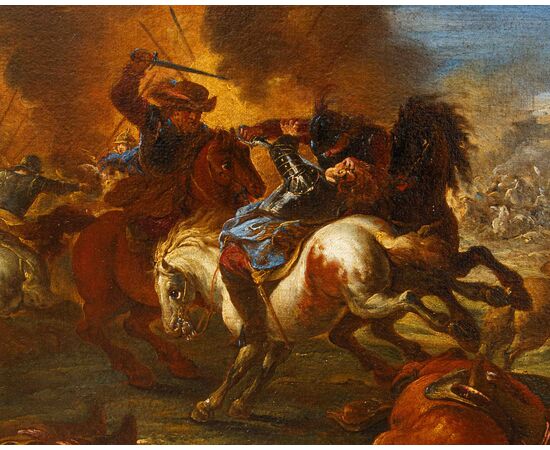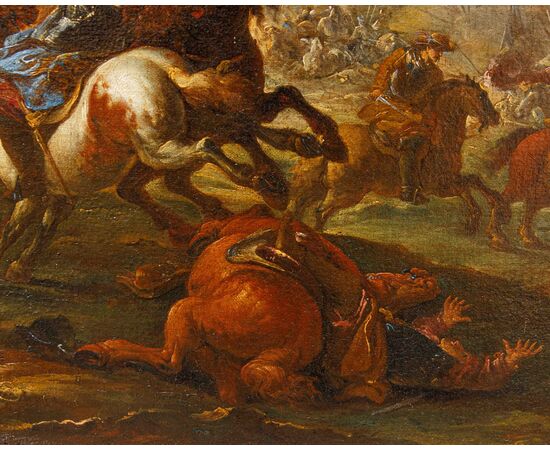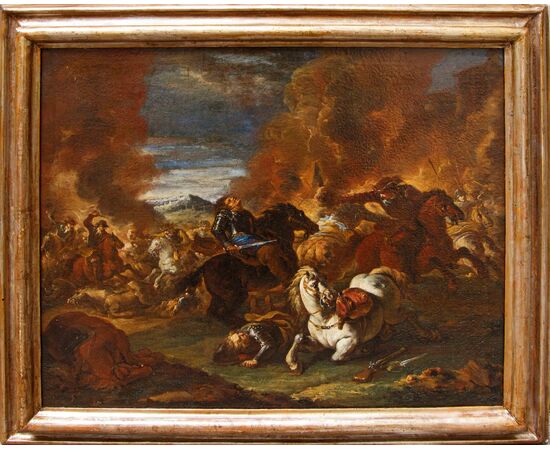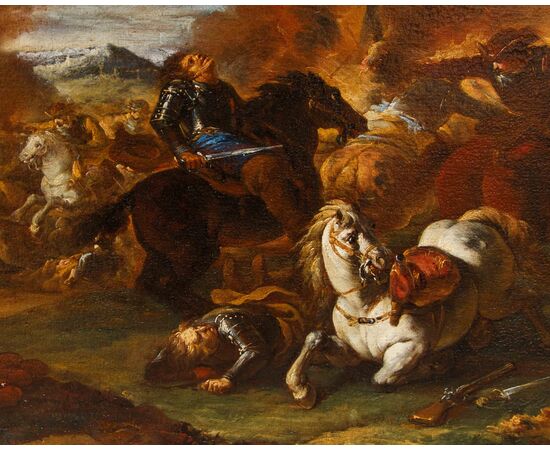Workshop of Francesco Monti, known as il Brescianino (Brescia, 1646 – Piacenza, 1703), Pair of battle scenes
Workshop of Francesco Monti, known as il Brescianino (Brescia, 1646 – Piacenza, 1703) Pair of battle scenes (2) Oil on canvas, cm 59.5 x 74.5 cm With frame, 75 x 88 The pair of canvases in question depicts a clash between knights with firearms. The brilliant armors of the combatants stand out against a sky full of clouds, in front of the profile of a city and a suggestive natural landscape. The scene is captured in the foreground, according to a typical trick of the battles painted in Northern Italy in the second half of the seventeenth century, and, in particular by Francesco Monti and the members of his school, in order to make the viewer feel like a direct witness of the scene they are witnessing. This turns out to be one of the key characteristics of Brescianino's production, to which are added a great chromatic vivacity, the play of various perspectives and careful stage direction. A peculiarity of the painter and the members of his circle is the representation of the combat in the foreground, described with chromatic vivacity and careful stage direction. The episode of the white horse half-fallen to the ground with the rider unseated, as well as the clash of two characters in the center, are elements that recur in the repertoire of the Brescianino, as can be seen in works such as the Battle Scene of the Stuard Art Gallery or the Battle of Palazzo Rivella. Francesco Monti, known mostly as Il Brescianino or as Il Brescianino delle battaglie, was born in Brescia in 1646. Pellegrino Antonio Orlandi (1704), who was his first biographer, informs that he had the Lucca painter Pietro Ricchi as his master. All subsequent literature has accepted the news, mostly hypothesizing that the apprenticeship took place during Ricchi's Venetian stay, placed in the third quarter of the seventeenth century. The total absence of data on Monti's youthful activity, however, makes it almost impossible to assess the influence of Ricchi's style in his formation and, on the other hand, it is not easy to identify derivations from the master in subsequent production. Monti was also a student of Jacques Courtois called Borgognone, as it appears from Orlandi himself and from a letter sent to Monti by his friend Carlo Giuseppe Fontana in 1694, reported in the monograph dedicated to the artist of Brescia origins by Arisi (1975, p. 34). The magisterium of Borgognone, although the chronological and geographical circumstances are unknown, must have played a decisive role in Monti's perfection as a painter of battles. The difficulties of outlining a certain catalog of his work, however, in the absence of a sufficient quantity of documented paintings, are also reflected in the definition of this artistic relationship: symbolic of the influence of Borgognone on the Brescianino is the diptych of Battles of the Accademia dei Concordi of Rovigo, attributed for the first time to the artist of Brescia origin in 1981 by Romagnolo. During the formative phase, the artist carried out numerous trips that led him to various locations of the Peninsula: particularly significant was the one in Naples, where he had the opportunity to observe firsthand the work of Salvator Rosa, which strongly influenced his entire pictorial production. Fundamental works to define and understand the stylistic characteristics at the base of the Brescianino's production are the six paintings of the Rocca dei principi Lupo di Sorgara, the Battle of the Sanvitale Museum of Fontanellato and the Brawl between knights of the Palazzo Farnese of Piacenza. Having reached full artistic maturity, Brescianino permanently entered the service of the Farnese in 1681: numerous are the works, mainly of war subject, made by the artist for the centers of Parma and Piacenza in the last twenty years of the seventeenth century. Particularly appreciated at the Farnese court, the artist was able to build a prolific workshop in Parma, where figures such as Giovanni Canti, Ilario Spolverini, Angiolo Everardi, called the Fiamminghino, and Lorenzo Comendich were formed. Monti's paintings are characterized by wide spaces "that are lost between smoke and dust", by the tangle of armed men in the foreground with unseated knights and horses rearing up in the last moment of life. In addition to the battles, which certainly constitute the most consistent and interesting segment of his production, the painter executed religious paintings and seascapes in which one sees the influence of Pieter Mulier, called Il Tempesta, with whom he had a deep friendship. After having given life to an active and initiated workshop, the artist died, probably in Piacenza, in 1703 (Sestieri, 1999, p. 206). The analogies with the style of the Brescianino lead to attribute the pair of paintings to a direct member of his school, among which we remember Giuseppe Nicola Domenico Monti, "who followed the paternal footsteps" (Orlandi, 1661) and Giovanni Canti, who was probably the author of Joshua who stops the sun, previously assigned to his master (Arisi 1975, n. 26).














